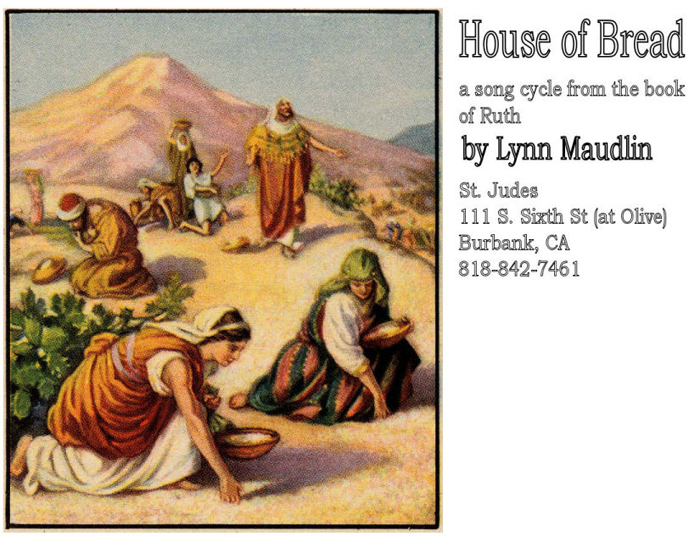One night after a worship team rehearsal I was asked what I'd written recently and I shared this song with
Sally Heimann, one of St. Judes' worship leaders at the time.
She said it sounded like a song from a musical; amazingly, that thought had never occurred to me. We laughed about it and
she said, "Yeah, you could have Orpah sing, "Bye bye! So long! Farewell!" and I thought that was really amusing. But I warmed
to the thought and gradually started writing other songs; my goal was to tell the Naomi-Ruth-Boaz story and stay consistent with
the account from the Bible.
I have performed portions of the piece at Azusa Pacific University at the request of two professors for several
different classes. With the generous support of the St. Judes' worship team,
we presented House of Bread in its entirety on Saturday, June 23rd and Sunday, June 24th, 2007. The audiences were moved and
delighted - lots of applause; it will be staged again, God willing and the creek don't rise!
More details and the program book can be found at
RuthMusical.com, including an explanation
of
gleaning.
I don't yet have suitable recordings but all the lyrics are linked at the
House of Bread
song list and also at
Moonbird Music
Co.


Written by Lynn Maudlin, © Moonbird Music Co. 2000-2005 - all rights reserved.

Some background on Ruth:
It's very hard for me, as a 21st century American, to relate to "levirate marriage" where the brother of the
deceased husband marries the childless widow in order to raise children in on behalf of his brother. To generalize, women
historically had two life paths available to them: to marry and raise children or to be a harlot. In a time without Social
Security or welfare benefits, widows and orphans were especially vulnerable but a widow with a son had an advantage - they could
glean enough to survive and as an adult he would care for his mother. Deuteronomy 25 gives the law to Israel that insured God's
people would not be dishonored by neglecting their widows.
If a brother refused to take his brother's widow, she would take him to the elders (and court of public opinion) and make her
claim against him; if he continued to refuse, she would remove his sandal in their presence and spit in his face. Happily this
doesn't happen in the book of Ruth: these are near kinsman but not Mahlon's brothers. Boaz is clearly interested in redeeming
the land and marrying Ruth whereas the nearer kinsman, for whatever reason, is only interested in redeeming the land and chooses
to back out of the deal when he realizes he will be required to marry the Moabite widow. In this instance the go'el, the nearest
living male relative (the Nearer Kinsman, in our presentation), removed his own sandal in front of the witnesses as evidence that
he refused the responsibility; this action freed Boaz to marry Ruth.



